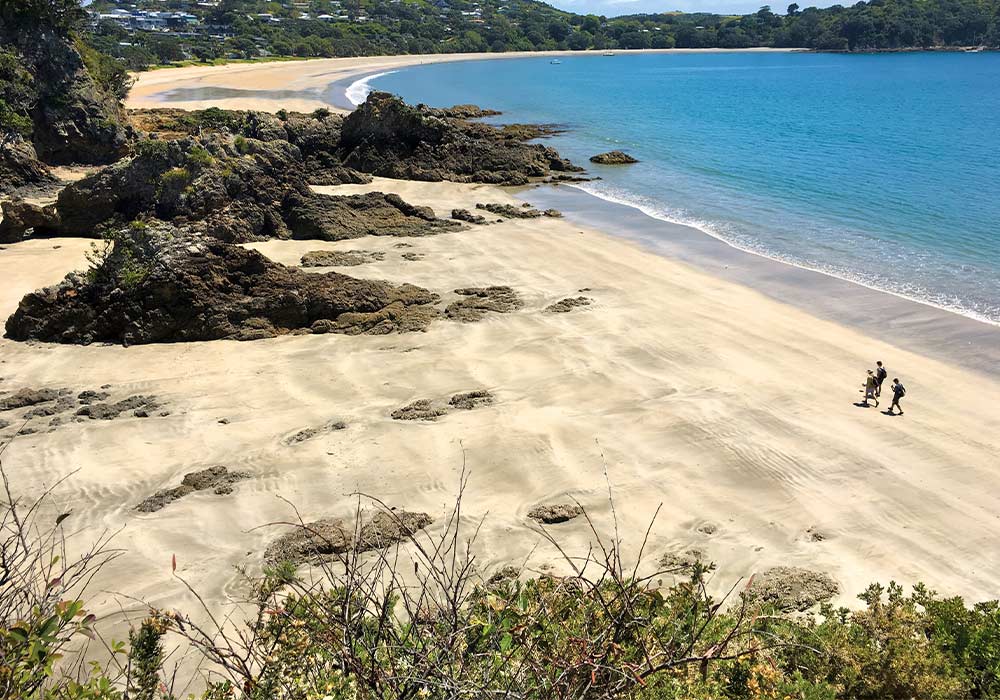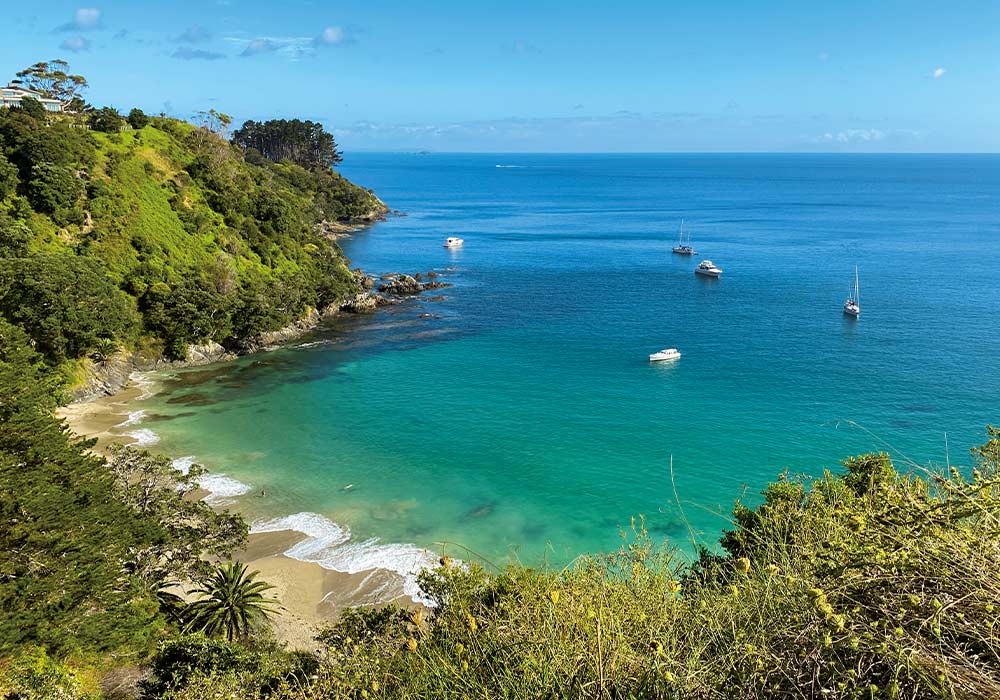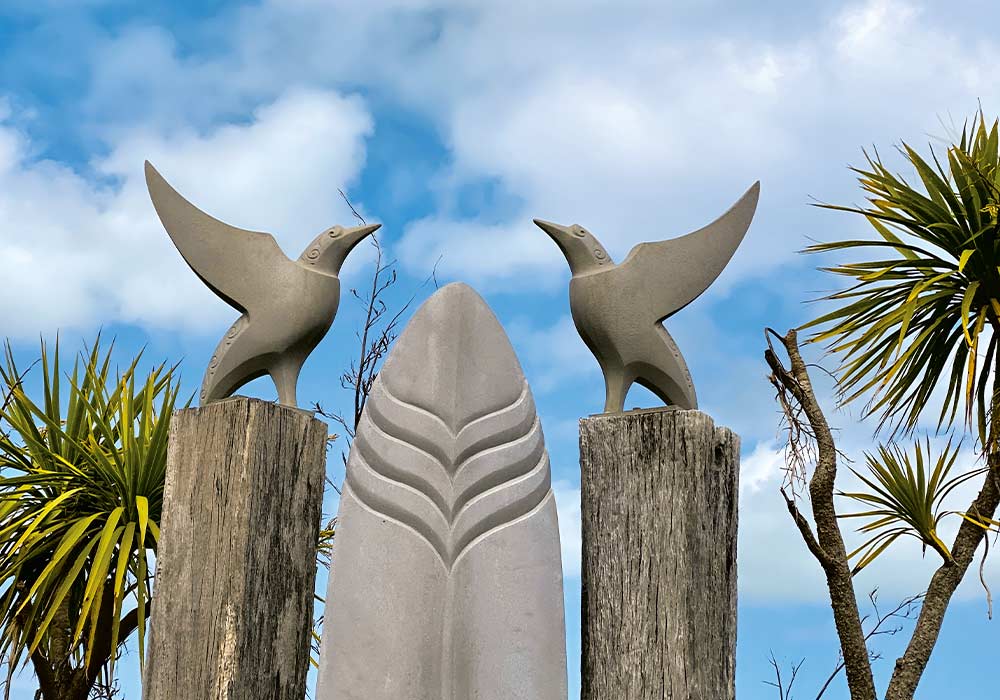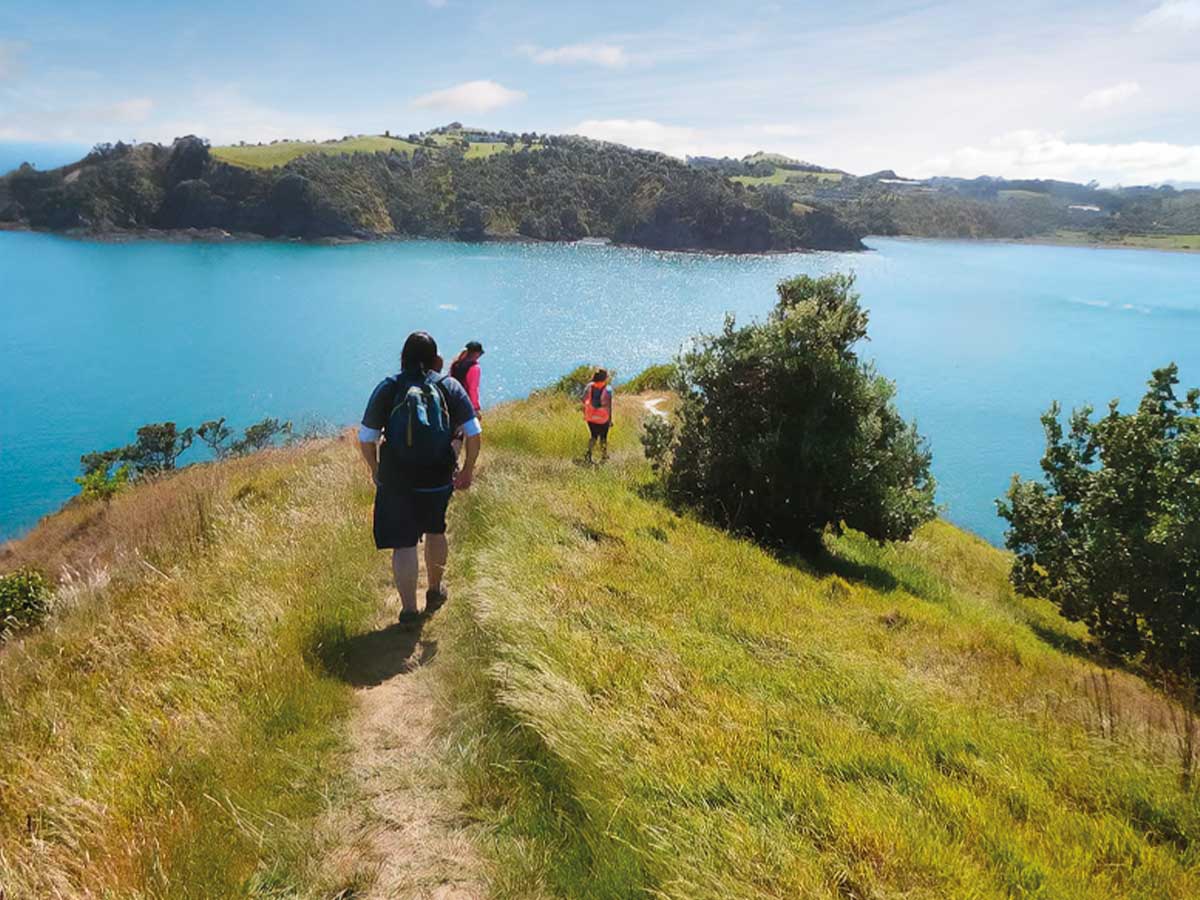Summer is the ideal time to get up close and personal with some of your favourite (or new) spots around New Zealand. In the first part of our series dedicated to summer walks, Pamela Wade explores Waiheke Island and discovers that opting for foot power over horsepower allowed her to view this familiar destination through fresh eyes.
I didn’t know whether to bless Gary or curse him. I had just crossed a creek in the bush and wandered along the track to a corner and there it was: yet another flight of wooden steps leading up a hill.
Gary Wilton and his Make Tracks team have been all over Waiheke Island, and Great Barrier too, taming the hills and making them accessible to people like me, out for an amble. They must have built thousands, and I’m beginning to feel as though I’ve climbed most of them.
That’s what happens when you set out to tackle Te Ara Hura. This is the 100km circuit of the island that Gary was the driving force behind, linking existing trails and cutting new ones to enable a complete circumnavigation of Waiheke.
The island is a lot bigger and emptier than most people realise. Empty of traffic and people that is, but full of bird-busy bush, open grassland, and quiet roads and certainly not short on stunning sea views, gorgeous bays, and enviable houses making the most of it all.
Te Ara Hura (path of discovery) is the most skite-worthy of the island’s walks, taking most people five days to complete, but there are many, many others on Waiheke, of all grades, lengths, and descriptions.

It’s undeniable, however, that the majority incorporate plenty of examples of Gary’s work, making the ups and downs more accessible in even the most mind-bogglingly remote places.
There are, of course, some refreshingly flat beach walks, though if you want to link them together, there’s usually a headland in between to tackle unless you’re clever about tides.
A good one is the stroll along Oneroa Beach’s creamy sand to the rocky eastern end, where an easy scramble past a noisy gull rookery and a dinky archway brings you to deservedly popular Little Oneroa.
Duly refreshed here, it’s an easy temptation to continue up Gary’s steps and through one of Waiheke’s many native bush reserves, maintained by local volunteers.
A quiet road leads to the path down to Te Aroha Avenue, where people live with no road access, tucked into bush filled with kākā and tūī. From the pebbly beach here, there’s another climb over to prosaically-named Sandy Bay and then a flat road wander to Enclosure Bay, world-famous on YouTube for its orca encounter in 2018.
You’re committed now, so carry on up through gorgeous McKenzie Reserve, unbelievably a pine plantation just 30 years ago, and follow the road to a magnificent view over Palm Beach.
Choose which sort of nature you want now: the clothing-optional end or the bush walk down to the main beach, with its wide sand, palm trees, and eateries. Fuelled up, you might be enticed into continuing onwards to Onetangi.

That’s Waiheke for you: there’s always just a bit further you can go, along a tempting track, with more views, more nature, and more beaches. And that’s how Te Ara Hura got under my skin and seduced me into taking on the whole circuit as part of the annual Walking Festival, held late last year. Guided, encouraged, and entertained, three dozen-plus of us, locals, and visitors, of all ages and nationalities, triumphantly knocked it off, enjoying the special detours across private land, but we could have done it anytime on our own, just like all the other trails on the island.
Try leaving the ferry terminal at Matiatia and tide allowing, veer left to stroll along the beach or alternatively, up through the bush. Follow this track around the coast, with glorious views towards Rangitoto and some lovely art in gardens along the route, and you’ll eventually fetch up in Oneroa, full of delights of all kinds to reward your efforts.
Or instead, go right up through the bush for more Gulf views, more tucked-away beaches, and enviable homes and also, within reach, a couple of world-class wineries: Cable Bay and Mudbrick. This section of the track is the location for the magnificent biennial Sculpture on the Gulf exhibition, running again for a month from late February 2024.
If you’re staying at the Poukaraka Flats campsite near quirky Rocky Bay, it’s a short walk to beautiful Whakanewha Regional Park. From the beach – watch out for the dotterels – you can choose your route up through the bush and nikau groves, past cascading waterfalls and tinkling streams, enjoying the sun slanting through the leaves above your head.
If you carry on up to the top, you can visit Batch Winery for some refreshment and fabulous views down over the island and across the water to the city’s distant skyscrapers. You might then be tempted to carry on across the island towards Trig Hill, where you can get some thrills on the rope-assisted descent (you’ll wish Gary had got here first) or instead strap in for a rapid swoop over the treetops with nearby Ecozip Adventures.
Wherever you go on Waiheke, you’ll discover tracks heading away up a hill, through bush, behind houses, shortcuts from one bay to the next, or winding away to who knows where, inviting you to find out.
One thing is certain, though: you’ll end up with a sincere appreciation for the work of Gary and his team. As well as trimmer thighs.
Te Ara Hura, Waiheke

delight for walkers
The collection of walks is the perfect way to explore Waiheke Island and discover its natural beauty.
Te Ara Hura walking track varies from short and easy through to more challenging, and all are connected. You can start at any point, finish wherever you want, and go in any direction.
The four areas of Te Ara Hura are:
- Headlands: The headlands walks are an introduction to the highlights of the island, all in one accessible space.
- Beaches ‘n’ Baches: This walk is off the beaten track. You will encounter the island character of the villages.
- Forest Heart: Escape the hustle and bustle and walk through beautiful native bush, old trees safe from possums, regenerating forests and streams, wetlands, and birds aplenty.
- Far End: The Far End of the network is a place apart from the rest of the island. Here, you’ll get big skies, big views, and fresh air therapy.
How to get there
For a day trip, take the Fullers passenger ferry from the city centre to Matiatia and use buses to get around. There’s a double-decker Explorer bus available too. You can hire cars, bikes, and e-bikes on the island.
For camping, take the Sealink car ferry from the city or Half Moon Bay to Kennedy Point, and drive to Ōmiha to the island’s only campsite, Poukaraka Flats Campground. Run by Auckland Council, this is quiet, flat, unpowered, has cold showers and toilets, and is by the beach. There’s limited freedom camping on the island; the maximum stay is two nights only.
Be sure to explore some of the island on foot.






